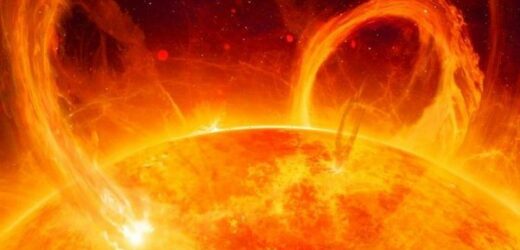NASA Solar Observatory captures solar flares in October
We use your sign-up to provide content in ways you’ve consented to and to improve our understanding of you. This may include adverts from us and 3rd parties based on our understanding. You can unsubscribe at any time. More info
Fast solar winds rocketed out of the Sun on January 29 along with a coronal mass ejection (CME). This means a solar storm has been tipped to reach the Earth by February 2. A CME is a large expulsion of plasma and magnetic field that explodes from the Sun’s corona (its outer layer).
These contain billions of tons of fast-moving solar particles as well as the magnetic field that binds them.
Dr Tamitha Skov, a space weather psychists, posted on Twitter: “Direct Hit! NASA, NOAA & MetOffice predictions agree the #solarstorm launched Jan 29 will hit Earth by early Febuary 2!”
She later added: “The earlier post showed NOAA/SWPC prediction. This one shows the NASA prediction, which indicated the #solarstorm could hit as early as 18:00 GMT on February 1.
“The final post is the Met Office prediction. This model shows the #solarstorm hitting by 05:00 GMT on February 2.


“So we have a range from 18:00 GMT on February 1 to 05:00 GMT Febuary 2. If the #solarstorm hits early, it will be faster and stronger; if hits late, slower & weaker!.”
When a solar storm arrives at Earth’s atmosphere, it can cause some problems.
US Space Weather Center (SWPC) ranks solar storms on a scale of “G1 Minor”, the least intense, all the way up to “G5 Extreme”.
But even the weakest of storms threaten “power-grid fluctuations” and have a “minor impact on satellite operations”.
At the stronger end of the scale, this is where it starts to get more dangerous.

When CMEs collide with Earth’s magnetosphere, “all of that extra radiation can damage the satellites we use for communications and navigation, it can disrupt power grids that provide our electricity”.
While the Met Office has said that the incoming storm is expected to be around either G1 or G2 in strength, it warned there “is also a slight chance of G3 strong storms”.
Its website also states that there is a chance of “radio blackouts”.
The National Oceanic and Atmospheric Administration (NOAA) predicts the storm will be around G2 in strength when it strikes on February 2.
And it warned that “increased drag on low Earth-orbit satellites is possible”.
DON’T MISS
EU fury: Nations fed up with bloc bureaucracy [INSIGHT]
EU blows top at Brexit Britain as it demands access to UK energy [REVEAL]
Biden comes to EU’s rescue and strikes crisis deal with VDL [REPORT]

And she warned that this could cause GPS and radio issues on Earth’s nightside.
The strongest solar storms can cause power outages that could even last days if the storm directly interferes with power transformers.
The SWPC warned: “During storms, the currents in the ionosphere, as well as the energetic particles that precipitate into the ionosphere add energy in the form of heat.
“That can increase the density and distribution of density in the upper atmosphere, causing extra drag on satellites in low-earth orbit.”

While solar storms may sound intimidating, they have a brighter side too.
Spectacular auroras lighting up the sky have been spotted time and time again when solar storms strike.
And you may want to cancel that trip to Iceland to see the Northern Lights, because you might even catch a glimpse of an aurora in the UK when the solar storm strikes.
The Met Office reported that visible aurora could be seen in north Wales and north Norfolk, and similar latitudes.
Source: Read Full Article


